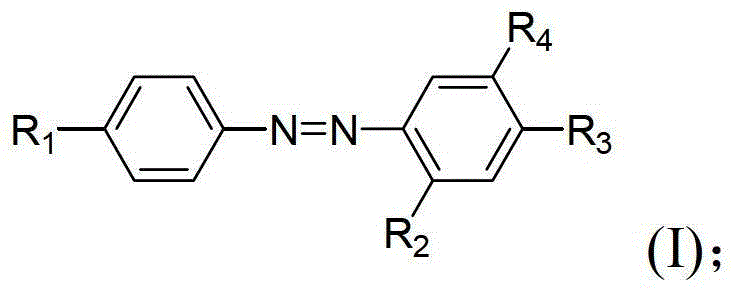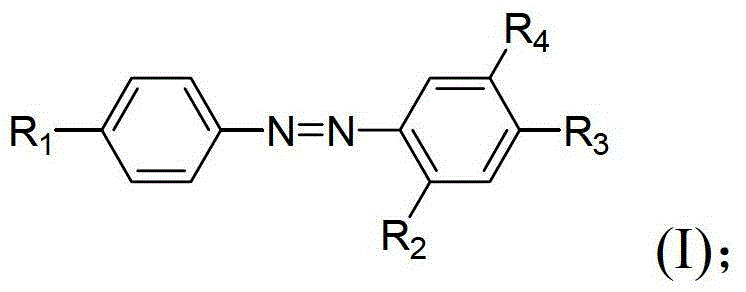Polymerisable yellow dye, ophthalmic lens material and ophthalmic lens
A yellow dye and ophthalmic lens technology, applied in the field of yellow dyes, can solve the problem of inability to apply ophthalmic lenses, and achieve the effects of good blue light blocking rate, avoidance of damage, and good physical properties
- Summary
- Abstract
- Description
- Claims
- Application Information
AI Technical Summary
Problems solved by technology
Method used
Image
Examples
Embodiment 1
[0053] Embodiment 1: the preparation of yellow dye (I)
[0054]
[0055] Under nitrogen, add 2.5 grams of 4-hydroxyazobenzene and 40 milliliters of dichloromethane into the round bottom bottle, accurately weigh 0.002 grams of dibutyltin dilaurate and 2.0 grams of isocyanoethyl methacrylate, Add to a round bottom bottle. After stirring for 5 hours, a large amount of water was added to wash the reaction product, and the dichloromethane was removed after dehydration and filtration to obtain a yellow dye (I).
[0056] yellow dye (I) 1 H-NMR analysis result is as follows:
[0057] 1 H-NMR (400MHz, CDCl 3 ):δ7.93-7.84(m,4H),7.51-7.43(m,3H),7.28-7.24(m,2H),6.29(s,1H),5.62(s,1H),5.37(1H,NH ), 4.31(m,2H), 3.62(m,2H), 1.97(s,3H).
Embodiment 2
[0058] Embodiment 2: the preparation of yellow dye (II):
[0059]
[0060] Under nitrogen, 2 grams of 4-hydroxyazobenzene, 1.6 grams of methacrylic acid, 2.36 grams of 1-ethyl-3-3-dimethylaminopropylcarbodiimide, 0.15 grams of 4-dimethylamino Pyridine and 30 mL of dichloromethane were added to a round bottom flask. After stirring for 12 hours, 20 ml of water was added into a round bottom flask for extraction. After collecting the organic layer, dehydration, filtration and removal of dichloromethane gave the yellow dye (II).
[0061] yellow dye (II) 1 H-NMR analysis result is as follows:
[0062] 1 H-NMR (400MHz, CDCl 3 ): δ7.88(m,4H),7.43(m,3H),7.20(m,2H),6.31(s,1H),5.72(s,1H),2.01(s,3H).
Embodiment 3
[0063] Embodiment 3: the preparation of yellow dye (III):
[0064]
[0065] Under nitrogen, add 1 gram of Disperse Yellow 3 (Disperse Yellow3) and 40 ml of dichloromethane into a round bottom bottle, and accurately weigh 0.001 gram of dibutyltin dilaurate and 0.6 gram of isocyanoethyl methacrylate Add to a round bottom bottle. After stirring for 5 hours, a large amount of water was added to wash the reaction product, and after dehydration, filtration and removal of dichloromethane, a yellow dye (III) was obtained.
[0066] yellow dye (III) 1 H-NMR analysis result is as follows:
[0067] 1 H-NMR (400MHz, CDCl 3 ):δ7.93-7.84(m,4H),7.51-7.43(m,3H),7.28-7.24(m,2H),6.29(s,1H),5.62(s,1H),5.37(1H,NH ),4.31(m,2H),3.62(m,2H),1.97(s,3H).
PUM
| Property | Measurement | Unit |
|---|---|---|
| modulus | aaaaa | aaaaa |
Abstract
Description
Claims
Application Information
 Login to View More
Login to View More - R&D Engineer
- R&D Manager
- IP Professional
- Industry Leading Data Capabilities
- Powerful AI technology
- Patent DNA Extraction
Browse by: Latest US Patents, China's latest patents, Technical Efficacy Thesaurus, Application Domain, Technology Topic, Popular Technical Reports.
© 2024 PatSnap. All rights reserved.Legal|Privacy policy|Modern Slavery Act Transparency Statement|Sitemap|About US| Contact US: help@patsnap.com










